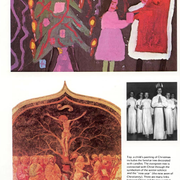KOZMOZIS @realchrisharold
Wall Street Apprentice
Mein Kampf
Feeling isolated? You're not alone.
Join 20,000+ people who understand exactly how your day went. Whether you're newly diagnosed, self-identified, or supporting someone you love – this is a space where you don't have to explain yourself.
Join the Conversation → It's free, anonymous, and supportive.
As a member, you'll get:
You've found your people. Create your free account
The Glass Universe: The hidden history of the women who took the measure of the stars by Dava Sobel
I'm reading Man and His Symbols. I don't fully get it, even if it's supposed to be divulgative material.
As far as I can tell, it's a layman exposition of Jung's theory of the unconscious, and how the collective unconscious expresses itself through symbols adquired by the primitive humans at some point in their evolutionary history. I have only read the first chapter, about a third of the book.
Half of me thinks it's interesting, the other half sees his theory as deeply unscientific and of dubious use in practice. It's the last book Jung wrote, and sometimes it feels like the efforts of an old man to justify his life-work to a myriad of people who consider it useless.
Jung idea is that mythological/religious symbols were acquired at some point by the primitive man, they express most notably when consciousness is supressed, which occurs during dreams, some meditative states, or people's fantasies (in children's thoughts, or sometimes during schizophrenia). In the first chapter he says that what the images that occur during dreams or fantasies are not always to be found in people's personal experience: "the images and ideas that dreams contain cannot possibly be explained solely in terms of memory," these images are similar to what Freud called "archaic remnants." Some of this ideas or patterns are innate and they repeat themselves in people's mind and practices across cultures, this patterns are what Jung called archetypes. In this book he says "the archetype is a tendency to form such representations of a motif - representations that can vary a great deal in detail without losing their basic pattern," also later in the first chapter: "What we properly call instincts are physiological urgees, and are pareceived by teh senses. But at the same time, they also manifest themselves in fantasies and often reveal their presence only by symbol images. These manifestations are what I call the archetypes. The are without known origin: and they reproduce themselves in any time or in any part of the world."How does the collective unconscious express itself through symbols? What sort of symbols?



Jung idea is that mythological/religious symbols were acquired at some point by the primitive man, they express most notably when consciousness is supressed, which occurs during dreams, some meditative states, or people's fantasies (in children's thoughts, or sometimes during schizophrenia). In the first chapter he says that what the images that occur during dreams or fantasies are not always to be found in people's personal experience: "the images and ideas that dreams contain cannot possibly be explained solely in terms of memory," these images are similar to what Freud called "archaic remnants." Some of this ideas or patterns are innate and they repeat themselves in people's mind and practices across cultures, this patterns are what Jung called archetypes. In this book he says "the archetype is a tendency to form such representations of a motif - representations that can vary a great deal in detail without losing their basic pattern," also later in the first chapter: "What we properly call instincts are physiological urgees, and are pareceived by teh senses. But at the same time, they also manifest themselves in fantasies and often reveal their presence only by symbol images. These manifestations are what I call the archetypes. The are without known origin: and they reproduce themselves in any time or in any part of the world."
I don't know what kind of symbols, but he seems to believe that many of this symbol can be found in the commonalities of mythological and religious thought. The symbols are the different forms through which the archetypes express themselves, alledgedly because this kind of pictorical representation through the unconscious is what precedes conscious linguistic and rational representations. This symbols are different in the specifics but share the different archetypal patterns.
See here a few I copied from the book:


The alledged clinical use is that, according to Jung, unconscious iinformation can present itself through symbolic representation through dreams. Dream analysis for Jung, implies identifying variation of these symbols, and considering the meaning that has been given to them and it's presumably innate (thus, making conscious what the unconscious is trying to communicate through symbolic representation, the only tool of the primitive mind), although variation in the symbols is to be expected due to life experiences.
TBH I'm not finding it as enthralling as Dava Sobel's earlier book Galileo's Daughter. Maybe it's because there are too many protagonists to follow, so the reader doesn't get to know each of them that well.That sounds so good. I put it on my book list.
And finally a excellent selection referred by a extremely intelligent forum member here:
Choke- Chuck Palahniuk
Ha! And I just bought the book you told me about, which features a Hamlet-inspired mouse on the cover.
Hope you enjoy it and laugh.
I’m sure I will. I’m already overjoyed with the mouse.